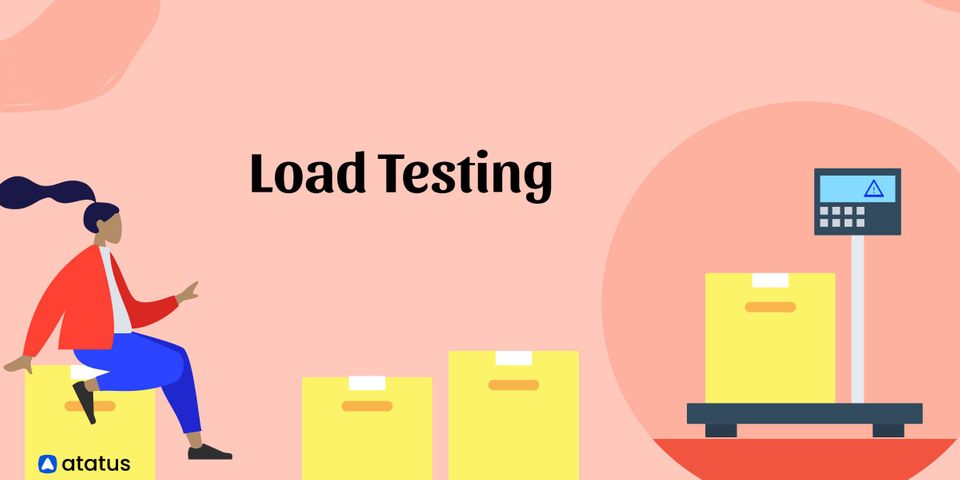What is Load Testing? Processes, Types, Best Practices, Tools, and More
Any software development project will almost certainly have through several tests by the time it is finished, especially in an Agile testing environment where testing and development occur simultaneously. But, no matter how many tests you've conducted, there's really only one way to tell if your software can handle the actual demands your army of end-users will be throwing on it once it's nearly finished. It's known as load testing.
As you read, you will know more about Load Testing as follows:
- What is Load Testing?
- Load Testing Architecture
- Process in Load Testing
- Best Practices for Load Testing
- Types of Load Testing
- How to Select Load Testing Tool?
- Tools for Load Testing
- Benefits of Load Testing
- Load Testing vs. Stress Testing
- Why Load Testing is Important?
1. What is Load Testing?
Load Testing is a type of performance testing in which any software, application, or website is subjected to a realistic load. Your application could fail badly in real-world scenarios if you don't have it. Load Testing establishes if a system, piece of software, or computing equipment can manage high loads given a high demand from end-users by examining how it responds under normal and high loads.
It's a type of non-functional software testing in which the performance of a software application is evaluated under a certain load. When a big number of individuals use a software product at the same time, it controls how it operates.
The following conditions are frequently discovered during load testing:
- It examines an application's maximum running capability
- It checks whether the current infrastructure is adequate for running an application
- It tests the application's capacity to withstand high user loads
- It specifies the maximum number of concurrent users that an application can serve, as well as its scalability, which allows more users to use it
2. Load Testing Architecture

We can see how different users interact with the application in the diagram above. Each user sends a request over the internet, which is then routed through a firewall.
Following the firewall, we have a load balancer that distributes the load to any of the web servers, then to the application server, and last to the database server, where it retrieves the required information based on the user request.
Load Testing can be performed manually or with the use of a tool. However, manual load testing is not recommended because the application is not tested for a lower load.
Assume we want to test an online shopping application to evaluate how quickly it responds to each user click, i.e. Launch URL, response time, Log in to the application and take notes on things like selecting a product, adding it to your basket, pay for it, and logging out. All of this must be completed for a total of five users.
So, instead of utilizing a tool, we can now physically load the application with five physical users from various workstations to test the application load for five users. In this case, it is preferable to perform a manual load test rather than purchasing a product and configuring an environment for it.
Consider the following scenario, if we need to load test for 1000 users or ten thousand users, we must automate the load test using any of the available solutions based on the technologies used in the application and the project's budget. If we have a large budget, we can use commercial solutions such as LoadRunner, but if we don't, we can use open source tools like JMeter, etc.
This is how the architecture looks while using the Load Testing Tool:

3. Process in Load Testing
The following are the steps involved in load testing:
- Setup of the Test Environment
The test environment for the load test is set up to start. In terms of hardware, network, and software specifications, the test environment should be set up as closely as feasible to the production environment. - Define Performance Criteria
In this step, the load test's performance metrics are defined, and the success criteria are finalized. This can include establishing acceptable throughput, response time, and transaction limitations, among other things. - Preparing for the Test
It entails creating a well-defined load test plan as well as setting up the test environment. - Creation of Virtual Users
It entails the creation of virtual user scripts, which comprise the numerous duties that each virtual user performs. Transactions could be used to measure the work done by virtual users. - Scenario Creation
During a testing session, a scenario is a collection of machines, scripts, and users. Scenarios are developed in LoadRunner utilizing the LoadRunner controller. There are two types of scenarios: Manual and Goal-oriented. - Putting the Scenario into Action
Multiple virtual users are used to simulate the load on the server by performing the operations at the same time. The scenario's configuration and schedule must be put up before it can be run. We can execute the full scenario, specific virtual users, or virtual user groups. - Monitoring the Scenario
Scenarios such as run-time transactions, system resources, web resources, network delay, and others could be tracked utilizing the LoadRunner web monitors. - Examining the Test Results
This is the most crucial stage of the load testing procedure. Graphs and reports created during the scenario run are used to analyse performance bottlenecks in this step. After addressing any issues discovered during the load test, the load test may need to be repeated.
4. Best Practices for Load Testing
It requires more than the best tool and software to execute effective load testing of your application. When it comes to load testing, the most important thing to know is best practices. Here are several tried and tested practices:
- Identifying Business Objectives
A thorough grasp of the company's objectives and scope will result in clear guidelines that will guide the process. - Test Case Creation
Make certain that all positive and negative scenarios are considered while writing a test case. It aids in the creation of the most effective and precise test cases depending on project objectives. - Key Measures Determination for an Application
Throughput, response time, resource utilization, maximum user load, and business performance are among the metrics included. - Understand the Environment
You should establish configurations for different sorts of deployments if you wish to test them. You should also check the system's many capacities, such as hardware, software, security, and networks, among others. - Decide the Best Tool
You should look into the most appropriate instruments for your needs. - Run Tests Incrementally
When all tests are executed or run at the same time, the system may fail. As a result, first, determine the volume and then gradually increase it. - Focus on Customers More
Keep in mind that client pleasure is a critical corporate goal. Satisfied clients are more likely to return to your site when they need something.
5. Types of Load Testing
Load testing can be accomplished in a variety of methods. A few load testing methodologies are as follows:
- Manual Load Testing
This is one of the load testing methodologies, however, it does not give reproducible results, cannot deliver measurable amounts of stress on an application, and is difficult to coordinate procedure. - Load Testing Tools created In-house
A company that understands the need for load testing may design its own load testing technology. - Open-source Load Testing Tools
There are various open-source load testing tools that are accessible for free. They may not be as sophisticated as their paid versions, but if you're on a budget, they're the best alternative. - Tools for Enterprise-level Load Testing
They usually have a capture/playback feature. They have the ability to accommodate a wide range of protocols. They have the ability to simulate a huge number of users.
6. How to Select Load Testing Tool?
It's critical to choose a tool that can help your team. We understand that performance testing takes time during the release cycle, but it is typically the harbinger of production success. Performance testing allows you to see how your application will perform in production before deploying it, allowing you to identify and resolve issues before going live.
Testing exposes whether your website performs differently under load, whether your code change has unintended consequences, and saves money in the long term by finding issues before they become costly production issues. Keep the following aspects in mind while evaluating a load testing tool:
- Easy to Build Complex, Realistic Load Tests – Is it simple to create complex, realistic load tests?
- Accuracy – Is it accurate and does it work in real browsers?
- Scalability – Can you scale up or down in terms of usage/use cases, users, and instances?
- Integrations – Can you integrate with the tools you use on a daily basis?
7. Tools for Load Testing
The following list includes licensed load testing tools; however, practically all licensed tools offer a free trial version, allowing customers to try out the software before selecting which is the best fit for their needs:
- LoadNinja – Users can use LoadNinja to diagnose web and API performance issues. It's easier to use than traditional load testing software, and it uses real browsers to give a more accurate picture of load.
- LoadFocus – Testing your websites, mobile and web applications, web services, and APIs is simple and economical with load testing, website speed testing, mobile emulation, automated website testing, SEO/PWA/speed monitoring, and software consultation services.
- WebLOAD - It's a JavaScript test script that allows you to add a huge number of protocols and then expand as needed. The recording is seamless and automatic with any web technology, including HTTP/HTTPS (SSL, TLS), and others.
- WAPT – It allows users to create and perform tests locally or remotely. Users can create tests, as well as remote, distributed, and cloud-based testing, server, and database performance monitoring, and more, using a browser or a mobile application.
- CloudTest – It enables you to safely and precisely mimic your most important events in production, while also providing live analysis of what your site or application is capable of on the big day and assisting you in pinpointing the source of any performance bottlenecks.
- LoadImpact – It's a cloud service for load testing the performance of websites, applications, and APIs, and it includes a new k6.io application with a redesigned Test Builder that focuses on API load testing. They also have a better session recorder in the browser and a more user-friendly results page.
- Parasoft Load Test – It allows users to take functional test projects created using SOAtest and utilize them for performance testing. Load Test Continuum (LTC), a web-based reporting tool, incorporates performance testing into the CI/CD workflow and automates performance testing.
- BlazeMeter – It enables Selenium functional testing without the need for coding. Using open-source tools like JMeter, Grinder, Locust, Selenium, and others, simulate thousands or millions of virtual users from over 55 geo-locations.
- Eggplant – It offers easy-to-use user-centric performance testing with the unique ability to simulate virtual users at both the application UI and network protocol levels, making it a solution that helps you understand the impact of UX at scale.
8. Benefits of Load Testing
Bottlenecks are discovered before production, scalability is increased, system downtime is decreased, customer satisfaction is improved, and failure costs are lowered. Specifically:
- Lower Failure Cost
Identifying issues as early as feasible, particularly before launch, lowers the cost of failure. After-launch failures, on the other hand, can result in tenfold higher costs. - Scalability
It can assist in determining an application's operating capacity limit. As the system grows, this can help determine infrastructure requirements. - Identifying Bottlenecks before Deployment
Prior to deployment, evaluating a piece of software or a website can reveal bottlenecks, allowing them to be resolved before they result in significant real-world expenses. - Reduce System Downtime
It can be used to identify scenarios that could lead to a system's failure. As a result, it's an excellent tool for predicting and solving high-traffic problems before they occur in the real world. - Improved Customer Satisfaction
One-time buyers will be more likely to return if a website's response times are quick even as it scales up to a larger audience.
9. Load Testing vs. Stress Testing
Load Testing, the most well-known and widely used sort of performance testing, includes putting a software application or IT system under normal demand to check if it can function as expected. Load Testing is similar to its larger, more severe cousin, stress testing, but it guarantees that a particular function, application, or system can simply manage what it's supposed to handle, whereas stress testing is about stressing things until they break, using unrealistic or unlikely load situations.
Both approaches can be useful in establishing how effectively a given piece of frontend software, like a website, or a backend system, such as the Apache server that hosts that website, can handle the actual loads it will encounter in normal operation.
Stress Testing causes failures on purpose so that you may assess the risk associated with the breaking points and, if necessary, adjust programs to break more gracefully. Stress testing is important for anticipating the unexpected and identifying how far a given system can be pushed, allowing for the exploration of the system's performance boundaries.
However, load testing is the best approach for ensuring that a software application or physical network can withstand the user requests and actions it is likely to experience under normal circumstances.
10. Why Load Testing is Important?
The tester is essentially modelling how the website or application would operate when hundreds, thousands, or even millions of users visit it in real life while testing it under load. Due to a shortage of system resources, the application may operate effectively for one user during functional testing but suffer when numerous users try to access it at the same time during load testing.
As a result, load testing is a superior way to investigate, analyse, and fix errors before they occur in real-time.
Even though you completed load testing as part of the testing process a few months ago, it is recommended that you do it again if the code has been altered numerous times since then. All of the code modifications performed after your load testing may have had an impact on the system's ability to handle the load.
It is a good idea to execute an automated load test as part of the continuous integration cycle to ensure that the end-user is not shocked by the system's performance.
Hiring load testers may be more expensive, but the expense of repairing a website that crashes in real-time is considerably more costly.
Summary
Load Testing is an important aspect of the software testing process since it guarantees that the software performs to the best of its ability. When load testing is done correctly, it produces high-quality software that adheres to industry requirements.
Load Testing is difficult, thus getting aid from specialists or learning to use load testing tools to make API testing easier and more adaptable is the best option.
Monitor Your Entire Application with Atatus
Atatus provides a set of performance measurement tools to monitor and improve the performance of your frontend, backends, logs and infrastructure applications in real-time. Our platform can capture millions of performance data points from your applications, allowing you to quickly resolve issues and ensure digital customer experiences.

Atatus can be beneficial to your business, which provides a comprehensive view of your application, including how it works, where performance bottlenecks exist, which users are most impacted, and which errors break your code for your frontend, backend, and infrastructure.
#1 Solution for Logs, Traces & Metrics
APM
Kubernetes
Logs
Synthetics
RUM
Serverless
Security
More





